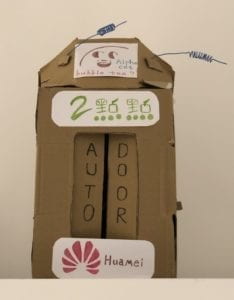Definition of Interaction
My definition of interaction is pretty strict. Firstly, just as the What Exactly is Interactivity has pointed out, interaction must consist of input, processing and output, where the input and the output should be visible, hearable, or touchable (, 5). And the output should change in accordance with the input. Such a process should also leave an impression on the person with whom it interacted with mentally, such as delight, sorrow, surprise, or even a simple “wow”.
Projects
The first project I’ve looked at is the Unsmart E-Pet, which I think is a very good interactive project. By putting together several light sensors as well as the distance sensors, the motors inside the e-pet would make sure the pet’s head is facing you when your head is moving. The pet would also turn its head when you are trying to pet it. My understanding was shaped because despite the e-pet can only respond you in two ways, you can see specific input and output when you are interacting with the robot, and its action is always so vivid, alive and cute that it would make me laugh. That’s what makes me feel it’s interacting with me.
The second project I saw was this Interactive LED Strip. In this project, the LED would light up when the user places the hand on top of the strip. I don’t think it’s an interactive design. Though the input and output are pretty clear, the process doesn’t make me feel anything special or different. It resembles the example in the reading of What Exactly is Interactivity, where the bulb would light up when you open the door of the fridge, which would turn off when you close the door.
The group project
The group project I’ve been working on is an automated bubble tea machine. The helmet first read the brainwave from the user’s head, and send the brainwave into the AI, which would interpret one’s desire in the specific bubble tea. When the AI has sensed the user is feeling confused, it would automatically recommend the most popular one to you. After the user has confirmed what he wants, the bubble tea order would be sent directly to the bubble tea shop. And when the person has arrived at the tea shop, the AI would assist him in taking the bubble tea by sending neural recognition, through which the tea-door would automatically open, waiting for the user to take away.



The project we designed was derived from my understanding of interaction, where I think the interaction is valid if it could stir up one’s mind, either it would be sorrow or happy. In our project, when ordering bubble tea, the user would be so surprised and happy at how well the machine knows him or her mind.
What’s more, it also related to my strict idea of input and output. We shouldn’t be expecting a fully automatic civilization in the future, where there’s merely any input from human and the AI is deciding everything for us, all we have to do is to sit back and become fatter. In our project, we are still having the input from human, but it is understood by the machine through a more next-generation style, the brainwave. The output is also very clear in this project, which is presented by sending out the bubble tea order and finally receive the bubble tea.